Antique Safavid Period Rugs and Carpets
View Our Early Period Rugs and Important Antique Carpet Collection
What was the Safavid dynasty?
The Safavid dynasty was a significant ruling dynasty in Persia (modern-day Iran) from 1501 to 1736. It marked a crucial period in the history of Iran, during which the country transformed into a powerful and culturally vibrant empire. The Safavids were notable for their promotion of Shia Islam as the state religion and for their significant contributions to Persian art, literature, and architecture.
Key points about the Safavid dynasty include:
- Founding: The Safavid dynasty was founded by Shah Ismail I in 1501. He claimed descent from the Sufi mystic Sheikh Safi al-Din Ardabili, whose teachings had a profound influence on the early Safavid rulers.
- Promotion of Shia Islam: The Safavids played a significant role in the promotion and consolidation of Twelver Shia Islam as the state religion. Shah Ismail I officially declared Twelver Shia Islam as the state faith, and subsequent rulers further strengthened its position. This move was crucial in establishing Iran as a center for Shia Islamic learning and scholarship.
- Expansion and Consolidation: Under Shah Ismail I and his successors, the Safavids embarked on military campaigns to expand their territories. They faced both internal and external challenges but eventually succeeded in consolidating their control over most of present-day Iran and parts of neighboring regions.
- Golden Age: The Safavid period is often referred to as Iran’s “Golden Age.” During this time, there was a flourishing of Persian art, poetry, and culture. Notable poets like Hafez and Saadi, and artists like Reza Abbasi, contributed to the cultural renaissance of the period.
- Shah Abbas I: One of the most influential Safavid rulers was Shah Abbas I (reigned 1588-1629). He is known for his effective administrative reforms, revitalization of the economy, and significant urban development. His reign is considered the zenith of the Safavid dynasty.
- Decline: After the reign of Shah Abbas I, the Safavid dynasty faced internal strife, weak leadership, and external pressures from neighboring powers, such as the Ottoman Empire and the Mughal Empire. These factors contributed to the gradual decline of the dynasty.
- End of the Dynasty: The Safavid dynasty came to an end in 1736 when Nadir Shah Afshar, a military leader, deposed the last Safavid ruler, Sultan Husayn, and established the Afsharid dynasty.
Despite the end of the Safavid dynasty, their influence on Iranian culture and identity persisted. Iran’s majority Shia Muslim population, the prominence of Persian as the language of literature and communication, and many architectural marvels from the Safavid era are a testament to their enduring legacy.
History and Evolution of Safavid Rugs
Safavid Rugs – The Timurid dynasty did not far outlive the fifteenth century. In the west it had already lost power to Turkoman dynasties in Mesopotamia and Northwest Persia. But these were swept away by Shah Ismail about 1501 who, supported by nomadic Turkoman troops, established a new “Safavid” dynasty all across Iran which lasted until the early eighteenth century. Safavid rug weaving was above all a sophisticated urban phenomenon, reflecting the cutting edge of Islamic artistic design more generally.
Safavid rugs relied overwhelmingly on the sinuous patterns or arabesques developed initially in manuscript illumination and architectural décor, developing a unique antique rug style. And although allover designs were not rare, Persian rugs of the Safavid period tended to use the large central medallion format developed in the last phase of Timurid rug production.

Sanguszko Carpet, Kerman, Persia, late 16th century, Museum of Decorative Arts, Paris, (from V. Berinstain et al., Great Carpets of the World, fig. 106)
One could reasonably argue that the medallion format and arabesque detail in rug weaving attained new heights of perfection under the Safavids. This went hand in hand with the development of increasingly fine techniques of weaving that facilitated the rendering of intricate, curvinlinear detail.
Scholars have tended to attribute the centers of Safavid weaving to the major cities or centers of power. Tabriz, Ismail’s initial capital, was certainly one such center. The later capital of Isfahan has also been accorded status as a center of production, with many outstanding seveteenth-century Safvaid carpets attributed to it, although there is no hard documentation for this. Safavid carpets were woven in Kashan.

Safavid Carpet, Kashan, Persia, 17th century,
Metropolitan Museum of Art, New York
Kerman was a also major center of production for the well-known “vase-carpets” of the seventeenth century. While carpets must have been made in many areas of Safavid Iran, it is still surprisingly difficult to make specific geographic attributions for Persian rugs of this period.
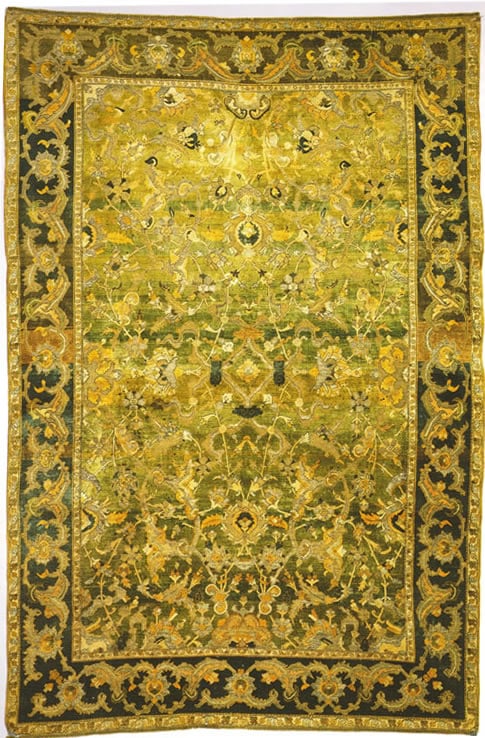
Polonaise Carpet, Iran, 17th century, ex. Coll. King Umberto of Italy, (from V. Berinstain et al.,Great Carpets of the World, fig. 152).
The Safavid dynasty produced an abundance of local arts during the 16th century. Classic Persian carpet weaving flourished in this period (from 1499 to 1722). Shah Tahmasp (1524-76) promoted the arts and was a painter, as well as a carpet designer. Under his tutelage decorative arts evolved. Shah Abbas the Great (1587-1629) continued this legacy. Design changed from curvilinear to rectilinear and new designs emerged. Intricate patterns were drawn on cartoons which the artists implemented into their weaving. There are only 2500 to 3000 carpets and fragments that have survived from the Golden Age of the Safavid dynasty. The most famous is the Aradil Mosque carpet dated 1539, which is on display at the Victoria and Albert Museum in London.
The four most important rug weaving centers were located in central Persia, Tabriz, Kerman, and eastern Persia. Oriental Rugs from central Persia were woven in Kashan and Isfahan. Kashan is noted for its use of silk pile. Shah Abbas moved his capital to Isafahan in the late sixteenth century and set up a factory to produce silk and metal brocaded carpets. Tabriz, the first Sefavid capital was also an important weaving center.
Tabriz was ultimately overrun by the Turks during the 16th Century and the seat of government was moved temporarily to Kazvin and eventually to Isfahan. The antique Oriental rug production also existed in Kerman, where vase carpets are assumed to have been woven. Eastern Persia also produced rugs during the Safavid period. As an example, Herat was a major city in eastern Persia and many rugs are known by this name.
The Story of the Lost Safavid Empire Carpets
One of the elements that makes carpets more beautiful is their fragility. Although one can indeed find many examples of antique rugs in existence that are several centuries old, the fact of the matter is that rugs are made from organic materials, and eventually, over a few millennia, they will break down.
The Safavid Dynasty changed the carpet industry forever, and there are some beautiful examples of Safavid Empire carpets from this Golden Age. However, these early rugs are rare as most of them no longer exist. We do have clues that can give us a glimpse into the spectacular carpets that existed but have been lost. The work of painters provides this glimpse, and it is through this medium that we can explore the magnificent antique carpets that led to the success and power of the Safavid Dynasty.
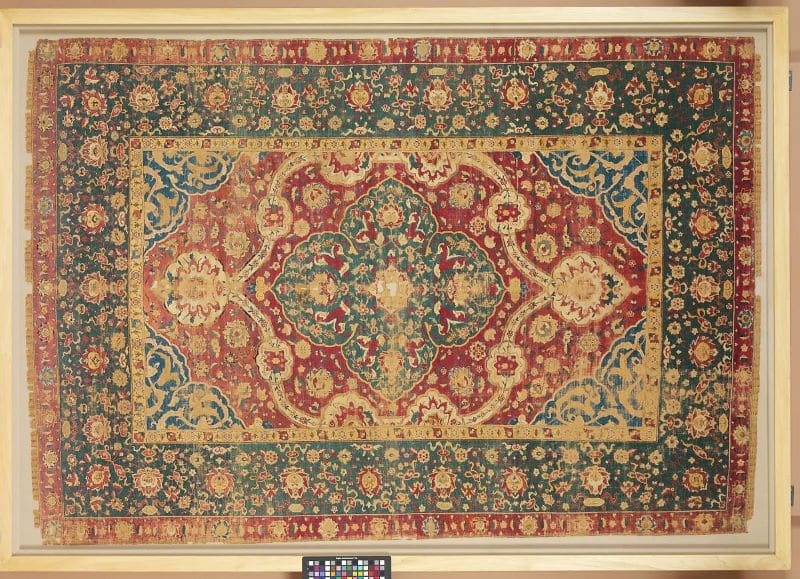
Silk Kashan Safavid Empire Carpet, owned by the Met.
How Many Safavid Empire Carpets Exist?
People can take steps to preserve carpets for as long as possible, but eventually, even with our best efforts, they will break down and cease to exist. It is estimated that there are only about 2,500 to 3,000 of the Safavid carpets left in the world.
Currently, the oldest carpets that we have from this period are about 500 years old, many of which are only small fragments. The older the carpet, the rarer it is. Today, our best source for understanding carpet design and the carpets that existed in the past is through art history such as paintings and other mediums. It seems that artists throughout the ages were as fascinated by these awe-inspiring carpets as much as we are today.

The Anhalt Medallion Carpet, owned by the Metropolitan Museum of Art
One source of information is art from Europe and the Italian Renaissance which depicted these carpets in their artwork. However, this source only accounts for antique Oriental rugs that made their way into private collections in Europe. There are undoubtedly many more that were woven for which no surviving record exists. These beautiful pieces of artwork are lost to the world, but they provide fuel for the imagination.
Another source of information comes from the art of Persian miniature painting. An exploration of this world opens up the imagination even more and gives us a glimpse into life in this vast empire. Persian miniatures are tiny paintings that took incredible skill and an extremely tiny brush. They began to appear in the 13th century and were produced up through the 16th century. The greatest value of these paintings is not only in their beauty, but also in the information that they can give us about the world around the artist.
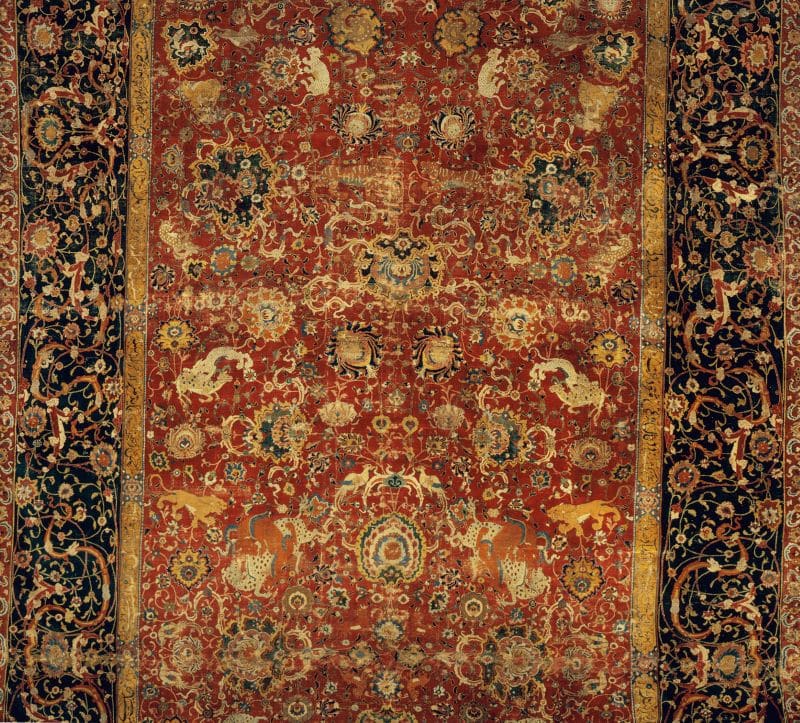
“The Emperor’s Carpet”, one of few Safavid carpets remaining, is at the Metropolitan Museum of Art.
Which Came First, the Safavid Miniatures and Painting or the Carpet?
One of the biggest scholarly debates surrounding miniature paintings is whether the carpet designs were produced from the miniatures, or whether the opposite was true and the artist was copying carpets that actually existed. Some claim the carpets represented in miniatures served as a pattern that was later expanded on to a larger grid, which would mean it would be used to produce the carpet. Others claim that the artists were drawing Safavid carpets that they experienced and encountered in their daily lives.

“The Feast of Sada”, a Safavid miniature owned by the Metropolitan Museum of Art. Safavid Empire carpets are depicted in these miniatures.
One factor of note that many scholars seem to forget is that the carpet designers and artists of the Safavid Dynasty were often formally schooled in several different disciplines. It is entirely possible that many of the carpet designers were also miniature painters. The two disciplines were not necessarily separate. It is more than likely that the answer to this “chicken and egg” argument lies in a little bit of both.
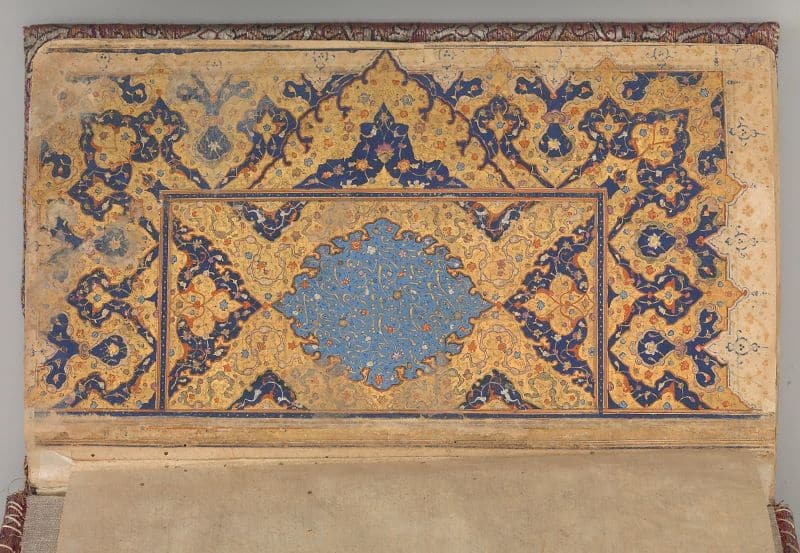
An example of a miniature at the Met.
What Do We Know About the History of the Safavid Empire Carpets?
Support and patronage of the arts began with the fall of the Timurid Empire and the rule of Shah Ismail I. Carpets are still in existence from the later Safavid Dynasty, but none exist from this earlier period that we know of. However, we do have miniatures to give us some clues.

Safavid Empire Carpets
These early miniature paintings of the Timurid Empire depict tile designs of repeating geometric patterns. They were in brilliant colors and often had a stylized form of Arabic writing in their borders. These “Kufic” border designs are a common element depicted in Islamic art miniatures of the time. Sometimes, these design elements are arranged in a checkerboard-like pattern. In these carpets, there is a distinctive field and border of some type.
In the 14th century, the designers began to break up the monotony of the tiled geometric motifs with medallions and field divisions with different elements. This process of breaking up the geometric patterns continued until, eventually, it evolved into the early medallion pattern rugs. These medallion rugs first began to appear in the early 15th century. It may be noted that personal prayer rugs and the introduction of the mirhab design started to appear about the mid-1400’s, as supported by Italian Renaissance paintings.

Mihrab Design in an Islamic Muslim antique Prayer rugs
In the 15th century, designs of carpets began to change considerably. It was during this time that large medallions appeared. The ornamentation in the field started to show curvilinear designs and the introduction of floral elements with long spiraling tendrils. Animals and plants were depicted using symmetrical mirroring on both the long and short axis of the carpet. This gave the carpets a sense of balance and rhythm. Eventually, the Kufic writing in the borders was replaced by abstract leaf tendrils and elaborate florals. Further development of the medallion pattern continued through the 16th century.
The introduction of these elaborate designs required a more complex system than weaving in the straight lines found in early Timurid carpets. It required fine rug weaves and the introduction of the rug cartoon or weaving from a pattern. It was during this time that one begins to see the separation of the designer and the craftsman who actually wove the carpet.
Did The Safavid Empire Carpets Actually Exist?
We can trace the artist trends through early miniature painting, but there are some who suggest that the only place these fantastic creations exist is in the mind of the artist. One interesting item of note is that the actual late Safavid period carpets in current existence differ from those that are depicted in miniatures produced at the same time.
Both the miniatures and the surviving late Safavid Dynasty carpets give us a glimpse into the world that laid behind the palace walls. It is a world of great beauty and extensive formal gardens. It is a world of bright colors and fabulous textures. In many other aspects of life, these painted miniatures are considered to be a highly accurate record of court life, so why would the same not apply to the carpets?
The antique miniatures tell us that many times the carpets were used outdoors to cover the ground, especially under large tents. These carpets are depicted on an enormous scale. One of the great mysteries is whether rugs of this massive size actually existed, or whether they are simply an element of the artist’s imagination.
Whether these large scale carpets existed or not requires the answer to one essential question: was it possible to create something this large with the tools and technology available at the time? To answer this question, let us look to the Guinness Book of World Records.
Currently, the largest carpet in the world is 133 meters long and 41 meters wide. It now resides in the central prayer hall of the Sheikh Zayed mosque in the United Arab Emirates. This gigantic carpet is the size of a soccer field.
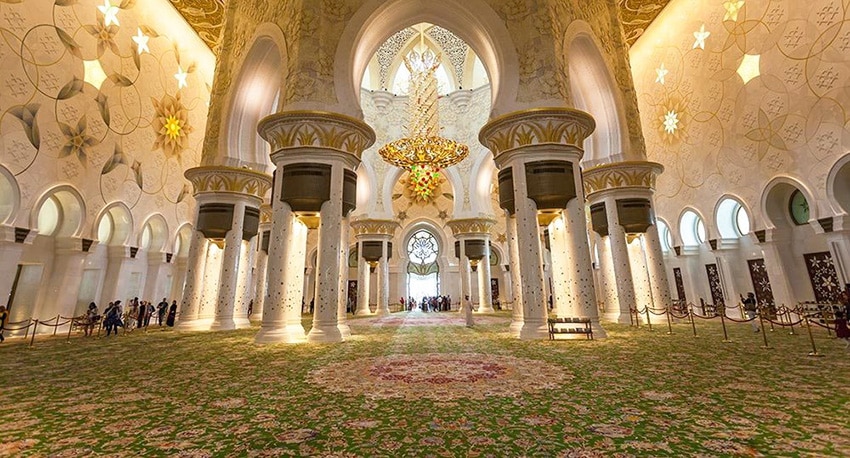
Largest Rug In The World Inside the Sheikh Zayed Grand Mosque In Abu Dhabi
It was produced in sections that were then stitched together, aligning the pattern so that they matched perfectly. The introduction of cartoons in the 1500’s means that the carpets depicted in the miniature paintings were technically possible at the time. What we know from the prayer rug at the Sheikh Zayed Mosque is that it was possible, but the effort that it took would be incredible.
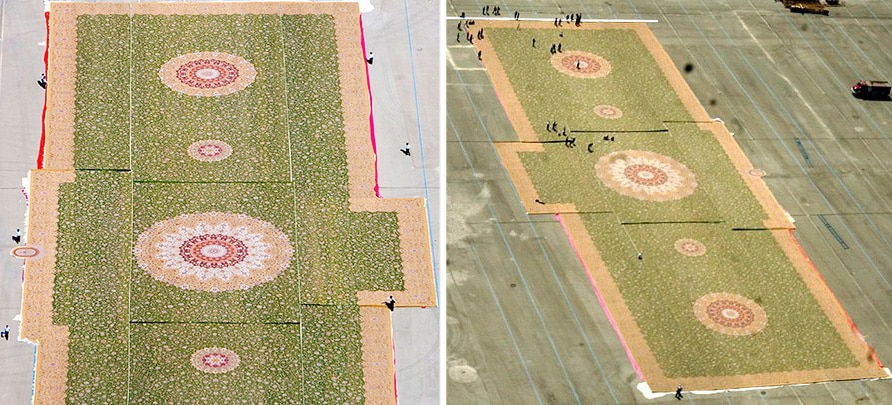
Arial View Of The Largest Rug In The World
The large mosque carpet required 1,200 weavers from three different villages to complete. These were the most experienced weavers who could be found. Production of this carpet took a year and a half to complete. It required 38 tons of wool and cotton and contains about 2.2 billion individually tied rug knots. The creation of this massive Persian carpet not only tells us that the rugs depicted in the miniature paintings are possible, but also, the enormous effort that was required to produce them.
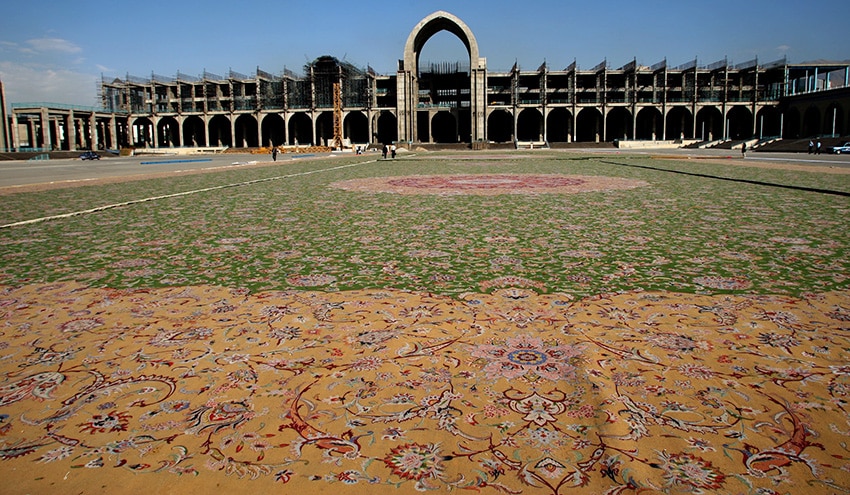
Largest Rug In The World On Display in Tehran Iran
So there you have it. The miniature artists of the Safavid Dynasty and before can tell us a lot about life. Through their eyes, we can see the beautiful carpets that are forever lost to the world. This makes our efforts at preserving the treasures that we still have even more critical.
We encourage you to search for rugs online on our website and explore some of the rare, historic pieces in our collection. We also encourage you to explore the world of miniature painting. In doing so, you can come to appreciate the talent of these hands that created treasures that are now, forever lost, except for the occasional glimpse that we get into this hidden world.

